The 10 Best eLearning Authoring Tools for 2025

Table of Contents
An eLearning authoring tool is an important component in creating e-learning content and a must-have tool for instructional designers, L&D professionals, and training businesses.
While many learning management systems nowadays come with built-in content authoring tools, they sometimes lack the advanced features of specialized eLearning software. This, and the portability factor, moving the learning content from one LMS to another, are the main reasons instructional designers prefer to work with e-learning authoring tools to develop online training.
There are many options to choose from. Here we will go through the most popular authoring tools and suggest the best use case for each one to help you choose the one that works for you best!
The Best eLearning Authoring Tools
What is an eLearning Authoring Tool?
An eLearning authoring tool is used to create different types of eLearning content, such as lessons, training, courses, assignments, exercises, simulations, and more. You can combine text, images, audio, or video to create a new interactive learning experience or create one from scratch.
Authoring tools export the final result into a SCORM, HTML5, xAPI, or TIN CAN file, which can then be imported into an LMS for delivering the training.
Do you need an authoring tool?
Specialized tools for online learning can be used to go beyond simple video lessons and basic assessments that most LMSs offer. If you need to create a customized learning unit for very specific purposes (e.g., an employee training course, a customer onboarding course, a comprehensive business coaching program for ambitious entrepreneurs, etc.), then you might need an authoring tool to achieve that.
Most professionals will be happy to use their LMS built-in tools. Using another e-learning authoring tool is suggested for advanced users, instructional designers, and trainers who are looking for very advanced and custom learning activities and need to create them themselves.
What to consider before choosing an eLearning content creation tool
To choose the right tool, you need to evaluate available options based on your specific requirements. Different requirements set by your client or for compliance purposes might require a different set of tools.
Consider the following:
Type of training: Is it a simple video training, or do you need to build an interactive learning experience? Does your training include software simulations? How important are tracking, grades, and reporting? All these will affect your choice of tool based on the features you’ll need.
Mobile learning: Today, mobile devices play a huge role in learning. As online learning evolves into mobile-first education, it is no longer simply mobile-friendly. The mobile learning market size crossed USD 58.7 billion in 2023 and is projected to observe around 16% CAGR from 2024 to 2032!
LMS compatibility: Not all LMSs are SCORM-compliant or support xAPI and TIN CAN. You need to see the requirements of your LMS and whether it is fully or partially compliant with the output of the content authoring tool. There is no point in building interactive content externally if you cannot import it to an LMS.
Budget: Be mindful of the budget. Authoring tools vary in cost, and some may come with additional costs for advanced functionalities. Compare the features you need against your budget and whether you can afford the tools you need.
Scalability: Authoring tools charge a per-user fee. If you have a team that requires different logins per user, then you need to plan ahead and think about whether that fits into the budget. Also, be mindful of future requirements, such as collaborative content creation or other features you might need later on.
Learning curve: If you have not used an authoring tool before or you are shopping for a new one, there will be a learning curve. More advanced tools are usually more difficult but may come with onboarding or training. Try a demo of the tool and see whether it feels intuitive enough before adding it to your toolkit.
What are the different types of authoring tools?
Αuthoring tools differ in terms of deployment type and pricing model.
So it matters whether it is SaaS/cloud-based, self-hosted or web-based on the cloud, desktop-based, or accessible on a mobile app (Android or iOS). Each has its advantages and disadvantages, and you need to look deeper into these.
Subcategories of authoring tools include assessment authoring tools, rapid authoring tools, interactive authoring software, and more. All these are tools specializing in a specific requirement.
Also, you have to look at pricing models and decide which one is the best for you. The most common pricing models are subscription, free, freemium, or one-time purchased licenses.
Tool #1: LearnWorlds – An all-in-one cloud LMS and Authoring Tool

LearnWorlds is an LMS with robust eLearning authoring capabilities, with recent updates to its assessment engine, form builder, certificates, interactive elements, and more. It is the best choice that combines hosting & authoring in one tool.
LearnWorlds focuses on providing the best learner experience and is SCORM-compliant to host content developed by other tools as well.
Best for
Individual course creators, instructional designers, SMEs, nonprofits, coaches, consultants, small enterprises, large businesses looking for a comprehensive platform to build their customer education programs.
LearnWorlds Pricing
LearnWorlds has three pricing plans which include authoring and hosting. High Volume & Corporate plans are available for bigger accounts:
You can compare the different plans here.
*Pricing information retrieved on January 31st, 2023.
Pros:
Cons:
Tool #2: Articulate Storyline 360
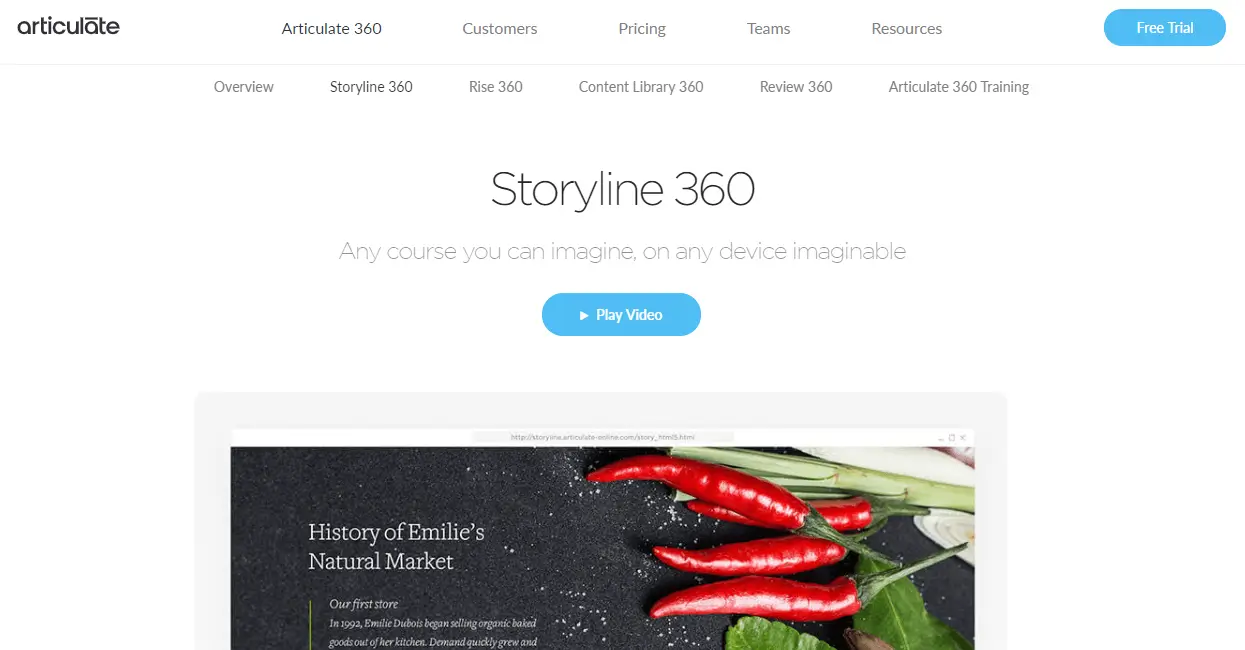
Articulate Storyline is a popular course authoring tool amongst many demanding course creators and instructional designers. Many are choosing it as their favorite tool because it has winning features and does what it promises to do.
Best for
Articulate Storyline 360 is more suitable for newer designers because of its ease of use. Also, it is an ideal choice for freelancers, academics, and businesses of any size or industry.
Articulate Storyline Pricing
There is only one price for business teams which is up to $1,399/yearly (per user/annually).
There are discounts for multi-year contracts or more than 10 team members.
*Pricing information retrieved from Articulate 360 on January 31st, 2023.
Articulate Storyline Support
Articulate Storyline support is available via live chat and online, where you can find help through community forums, training, resources, and articles on course building, books, tutorials, and user guides.
Pros:
Cons:
Tool #3: Elucidat
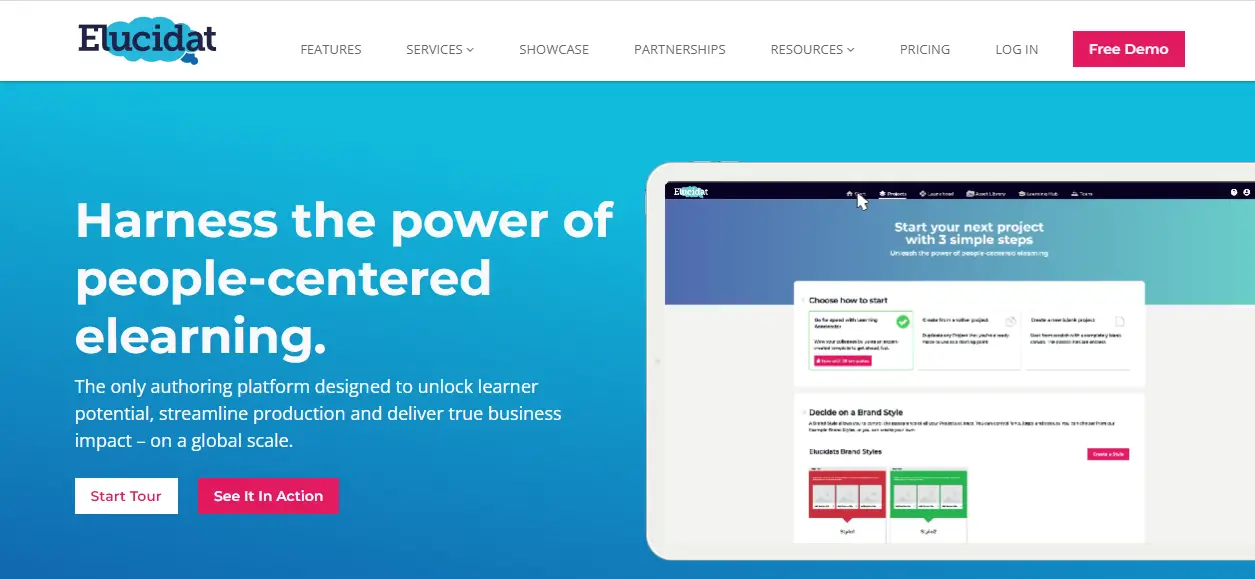
Elucidat comes with a beautiful, user-friendly interface, and modern and easy navigation, which makes it one of the easiest-to-use course creation tools in this list. While it doesn’t offer the flexibility to create your own course template, its 25,000 different ones are enough to compensate for that.
Best for
It is ideal for small/medium companies, large enterprises, and non-profit organizations.
Elucidat Pricing
Elucidat has four pricing options: Basic, Team, Enterprise, and Scale. Pricing is a combination of users, learners, and accessible features per plan.
Prices are not public, and you need to contact their sales representatives to get a quote.
*Pricing information retrieved from Elucidat on January 31st, 2023.
Elucidat Support
Elucidat live support is based in the UK and US, and they are available Monday to Friday from 09:00 to 21:00 (UK time). They also provide support via email and online via submitting a request. Outside of these hours, it has a help desk where you can search for articles written by the Elucidat team that offer advice and answers to the most common questions.
Pros:
Cons:
Tool #4: Adobe Captivate
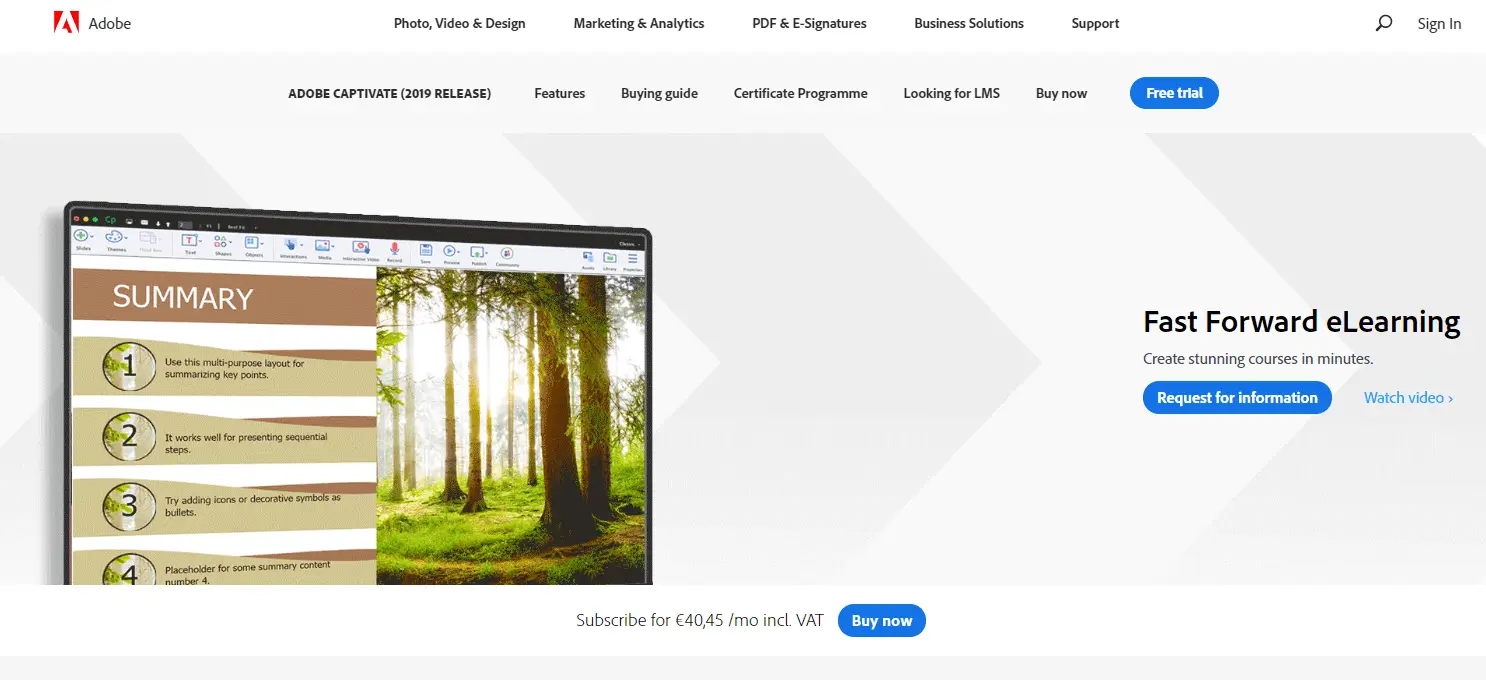
Adobe Captivate is a popular choice for an authoring tool, and it’s one of the top premium ones in the market. Depending on what you need it for, you can use it to create immersive learning scenarios, workflows, animations, record your PowerPoint presentation as a video, and add interactive overlays to build high-quality online courses. Adobe Captivate is one of the top rated and most recognized brands.
Best for
It is aimed for use by freelancers, small/medium companies, large enterprises, and non-profit organizations.
Adobe Captivate Pricing
Adobe Captivate has a subscription of $33.99 per month but is charged annually at $407.88
Access to Adobe Stock for additional assets comes with an additional $29.99 per month.
*Pricing information retrieved from Adobe on January 31st, 2023.
Adobe Captivate Support
Adobe Captivate support is accessed via email. Whenever you need help using the product, you can access their Help Center or their community forums, where you can ask other people or professionals for help.
Pros:
Cons:
Tool #5: Lectora Online
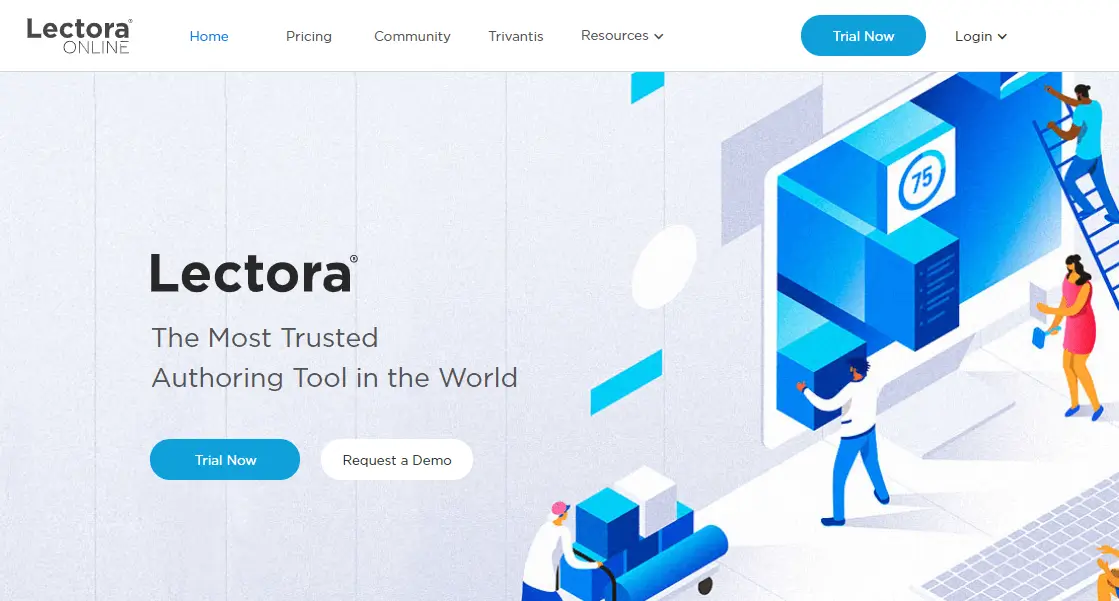
Lectora Online (ELB Learning) checks off the majority of the feature points that come with any course authoring tool. Packed up with a responsive design, automated versioning, interactivity, branching, quizzing features, and course template options, this tool will prove itself handy for creating elearning content.
Best for
It is ideal for freelancers, small/medium companies, large enterprises, and non-profit organizations.
Lectora Online Pricing
Lectora Online has three pricing plans per authoring suite based on features and usage:
*Pricing information retrieved from ELB Learning on January 31st, 2023.
Lectora Online Support
Lectora Online support is available during business hours. Outside of these hours, you can visit the ELB Learning community and, communicate with other users, check out their knowledge base or their blog.
Pros:
Cons:
Tool #6: iSpring Suite
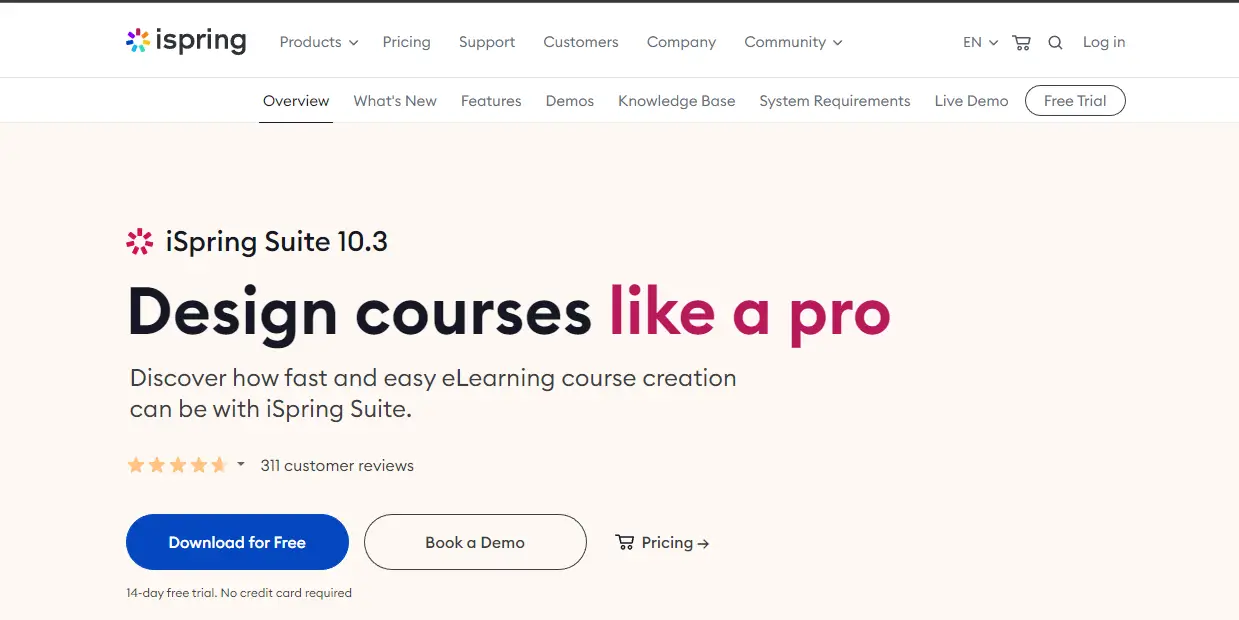
iSpring Suite offers a quick and easy elearning solution for authoring elearning training, enabling users to create online courses, and facilitate content creation for onboarding, product training, and assessments.
Best for
This authoring tool is great for new entrants who don’t need the full authoring capabilities of a more seasoned tool. It is suitable for academic institutions, freelancers and large enterprises.
iSpring Suite & Max Pricing
Volume discounts, lifetime licenses, academic, non-profit, and government discounts are available.
Additional costs apply if you are looking for extra features:
*Pricing information retrieved from iSpring Solutions on January 31st, 2023.
iSpring Suite Support
iSpring Suite support is available 24/7 via phone, email, and chat. On top of that, it has an online community with a range of forum activities and a support center with guides and articles you can browse whenever you need help using the tool.
Pros:
Cons:
Tool #7: EasyGenerator
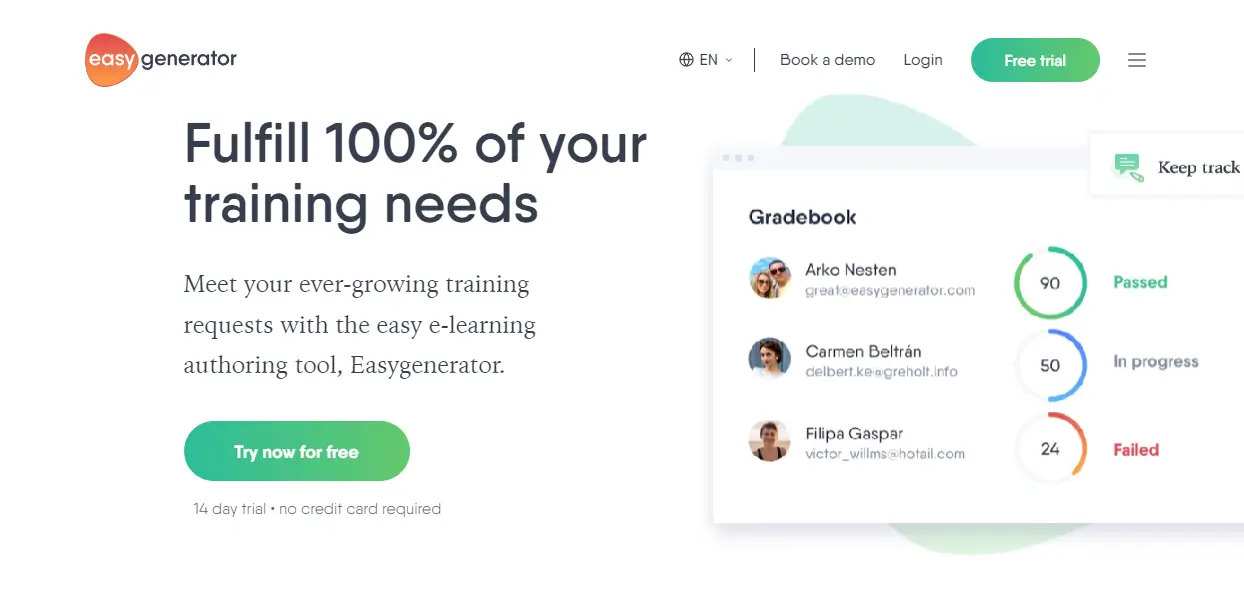
Just like its name says, EasyGenerator is super easy to use. It has rich interface options and it is great for use by people who are starting out and have no previous experience in creating online courses. This tool aims to simplify the course creation process to make it accessible to everyone.
Best for
It is ideal for people who have no elearning background. It is up for use by freelancers, small/medium companies, large enterprises, and non-profit organizations.
Easy Generator Pricing
Easy Generator has three pricing plans:
*Pricing information retrieved from EasyGenerator on January 31st, 2023.
Easy Generator Support
Easy Generator support is available during business hours and offered live online through Easy Generator Live. It also has a Help Center and a knowledge base that is full of articles divided by categories for easier browsing, as well as a resources page with case studies and a blog.
Pros:
Cons:
Tool #8: isEazy
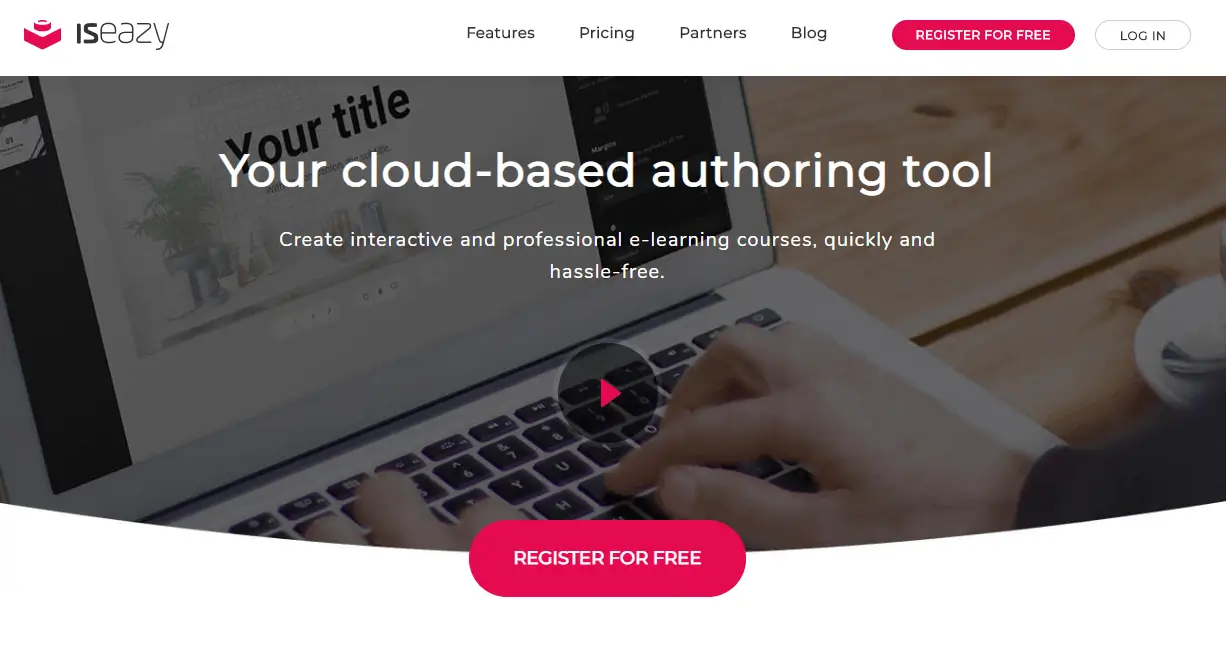
isEasy promises to help you create interactive and professional e-learning courses, as well as dynamic training content that is attractive and engages the user, quickly and hassle-free.
Best for
It’s ideal for freelancers, small/medium companies, and non-profit organizations.
isEazy Pricing
isEazy has four pricing plans available, including a free version:
*Pricing information retrieved from isEasy on February 02, 2023.
isEazy Support
isEazy support is available 24/7. It has a knowledge base you can visit whenever you need help using the tool. It has many example courses and demos you can check out, FAQs, and a blog with helpful guides and articles.
Pros:
Cons:
Tool #9: Evolve
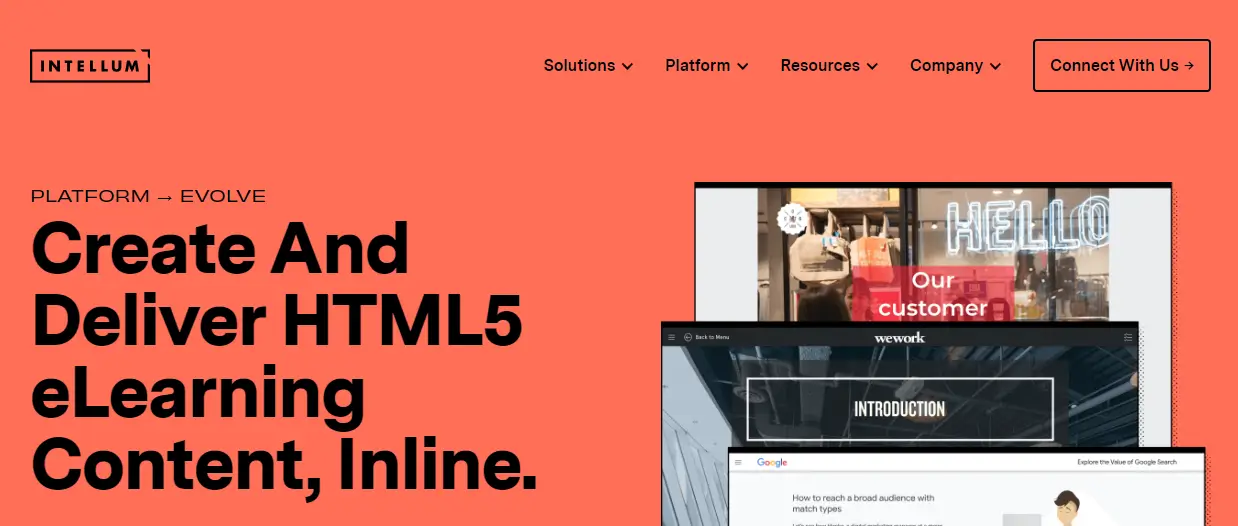
Evolve has quickly become the preferred content authoring tool for companies like Google, Randstad, Pearson, WeWork, and Cotton On. Using the tool, you can create interactive educational experiences, elearning courses, and simulations across devices.
Best for
It is ideal for freelancers, large enterprises, nonprofits, public administrations, and small/medium businesses
Evolve Pricing
Evolve has 3 plans offered in yearly installments only:
*Pricing information retrieved from Evolve on February 02, 2023.
Pros:
Cons:
Tool #10: H5P
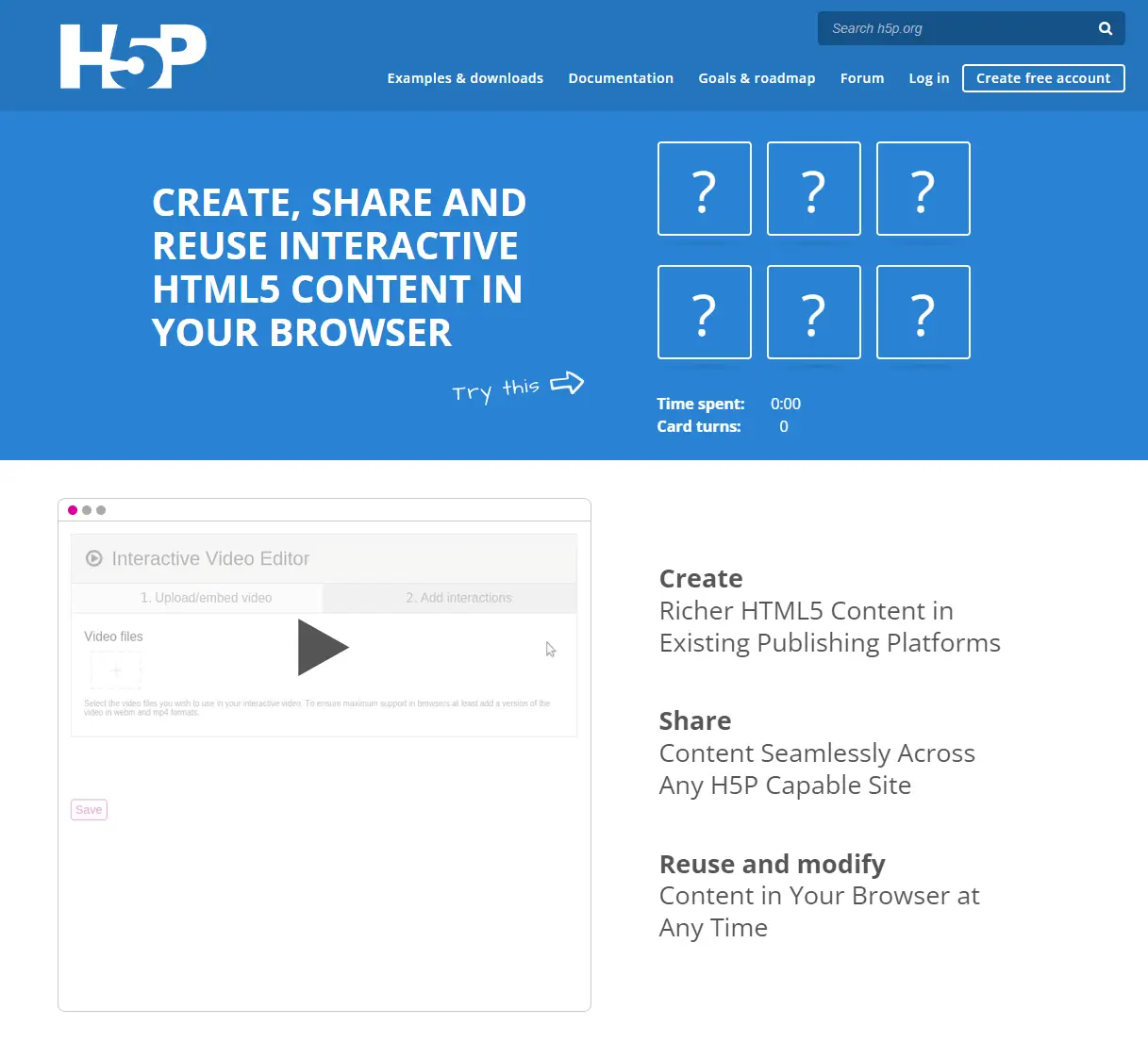
H5P is an open-source, community-driven system for creating rich and interactive multimedia for elearning. Thousands of universities, enterprises, school districts, governments, and other organizations use H5P to deliver interactive learning experiences.
It offers a number of learning units you can’t find in many LMSs, and you can also adapt it to use as microlearning units. Adding H5P modules to your training material will greatly enhance the content.
Best for
Instructional designers, small course creators, teachers, and academics. Elearning developers for businesses may use it to enhance their material but it’s not enough as a standalone authoring tool.
H5P Pricing & Hosting
H5P.org offers the tools to create learning units for free. If you have the coding skills to do some technical work on your own server, you can also host the content yourself and avoid the pricing costs.
For everyday instructional designers without the skills or dev team, H5P.com offers hosting options starting from $67 per month. It also offers heavily discounted prices to educational institutions.
*Pricing information retrieved from H5P.com on February 02, 2023.
Pros:
Cons:
Choosing the Right Authoring Tool
Choosing the right tool to create digital learning is essential for every instructional designer or course creator. Authoring tools come at various prices and with different features, but they have to also be compatible with your delivery method (LMS).
Make sure to note your requirements and evaluate each authoring tool based on them before choosing one. For example, many authoring tools still do not support camera or screen recordings, which is a requirement for some training.
If your tool of choice offers a free trial, take advantage of it and see how intuitive it is.
FAQs
What are authoring tools?
Authoring tools are software used to create e-learning content. They can be used to create different types of content, such as videos, quizzes, and simulations.
What are authoring tools examples?
Some examples of eLearning authoring tools are Articulate Storyline, Adobe Captivate, H5P, and iSpring.
What are the most popular authoring tools?
The most popular eLearning authoring tools are Articulate Storyline, Adobe Captivate, Lectora, iSpring Suite, and Easygenerator.
What are the 3 types of authoring tools?
There are a variety of e-learning authoring tools available on the market, but they can generally be divided into three categories: those that are standalone, those that are integrated into Learning Management Systems (LMS), and those that are cloud-based.
What is the difference between authoring tools and traditional word processors?
Authoring tools are specifically designed to create e-learning content, while word processors are more general-purpose software used for various tasks, such as writing papers or reports. Authoring tools offer features specifically useful for creating e-learning content, such as templates for different types of courses, wizards that walk you through the creation process, and ways to add multimedia elements like videos and quizzes easily.
Rosemary is LearnWorlds’ Content Marketing Manager. She has over 2 decades of experience in omnichannel marketing and content writing for the IT and SaaS industry. Her expertise lies in crafting effective content marketing strategies that attract, engage, and nurture customers, enabling LearnWorlds to reach its target audiences with precision.
Nick Malekos is a Senior Digital Marketer in LearnWorlds. He is a results based and well-rounded Digital Marketer with years of experience in the education industry, writer and digital literacy trainer.


